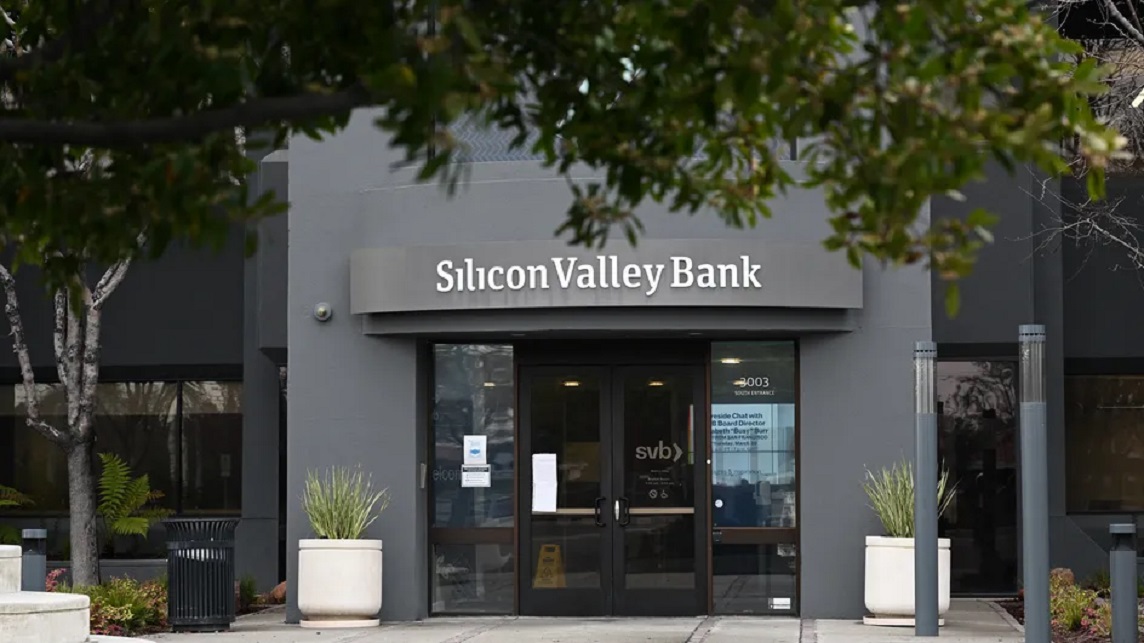To prevent potential panic in the financial markets and the spread of risk, the US government has assumed control over the technology-focused bank.  The headquarters of Silicon Valley Bank, in Santa Clara (California), on March 10, 2023. (AFP)
The headquarters of Silicon Valley Bank, in Santa Clara (California), on March 10, 2023. (AFP)
It’s a small earthquake in the world of finance. The Silicon Valley Bank (SVB) was closed on Friday March 10 by the American authorities. Little known to the general public, SVB had specialized in the financing of start-ups and had become the 16th American bank by the size of its assets. At the end of 2022, it had $209 billion in assets and about $175.4 billion in deposits. This is the biggest bank failure in the United States since the financial crisis of 2008. The news has shaken the financial markets, even if the experts try to be reassuring for the moment.
What caused this fall?
Philippe Waechter explains that Silicon Valley Bank caters to clients largely involved in the technology industry, and these thriving companies deposit a significant amount of money in the bank. SVB utilizes this money to invest in US Treasury bonds. A few weeks ago, the technology sector began to face challenges, according to the director of economic research at Ostrum Asset Management.”Companies wanted to recover part of this cash. And the bank was obliged to sell part of the accumulated portfolio.”
Except that with the rise in interest rates, the bank has accumulated losses. Quickly, the establishment was no longer able to cope with the massive withdrawals of its customers and its last attempts to raise money were unsuccessful. “There was a question of confidence vis-a-vis this bank”, sums up Philippe Waechter.
“Her clients said to themselves, ‘If she can’t raise funds, is she strong enough?’ Hence this banking panic.
Outside the bank’s headquarters in Santa Clara, Calif., a few nervous customers were still wondering Friday how they could access their funds. On the storefront, a message explained that it would be possible, from Monday, to withdraw up to 250,000 dollars. “It’s not good. A lot of the biggest [venture capital firms] have very high deposits here,” a client, a start-up boss, who used the bank to pay his bills, told AFP. employees.
What are the consequences ?
On the markets, the panic movement began on Thursday, when the SVB revealed that it was trying to raise capital quickly to deal with the massive withdrawals of its customers, without succeeding. The announcement surprised investors and rekindled fears about the soundness of the banking sector as a whole, particularly with the rapid rise in interest rates which is driving up the cost of credit.
The four largest US banks lost $52 billion on the stock market on Thursday and in their wake Asian and then European banks faltered. In Paris, Societe Generale lost 4.49%, BNP Paribas 3.82% and Credit Agricole 2.48%. Elsewhere in Europe, the German bank Deutsche Bank dropped 7.35%, the British Barclays 4.09% and the Swiss UBS 4.53%.
On Wall Street, the big banks rallied on Friday after the rout the day before. JPMorgan Chase gained 2.54% while Bank of America and Citigroup lost less than 1%. Medium-sized banks, on the other hand, are more in turmoil, First Republic, for example, dropping nearly 15% and Signature Bank, close to the cryptocurrency community, 23%.
How did the American authorities react?
The American authorities took official possession of the bank and entrusted its management to the American agency responsible for guaranteeing deposits (FDIC). US Treasury Secretary Janet Yellen summoned several financial sector regulators on Friday to discuss the situation, reminding them that she had “full confidence” in their ability to take appropriate action, and said the sector bank remained “resilient”.
“The American authorities reacted very, very quickly compared to what had happened before the great financial crisis of 2008”, notes analyst Philippe Waechter. They will now try to reassure American taxpayers: “The objective is to show that this situation is isolated, so the FDIC will manage the bank until things may return to normal”, continues Philippe Waechter.
Is there a risk of contagion?
Asked by AFP, Stephen Innes, analyst at SPI Asset Management, wants to be reassuring, believing that the risk of an incident for the big banks was “low”. Since the financial crisis of 2008-2009 and the bankruptcy of the American bank Lehman Brothers, institutions have had to give reinforced guarantees of solidity to their national and European regulators. They must, for example, demonstrate a higher minimum level of capital intended to absorb any losses.
For analysts at Morgan Stanley, quoted by AFP, “the funding pressures facing the SVB are very particular” and the other banks are not facing a “shortage of liquidity”. The opinion is shared by Eric Delannoy, president of the consulting firm Tenzing. “Whenever a bank is in difficulty, there is a fear of contagion. But in this case, it should not be the case because the bank in question is a Silicon Valley bank which financed start-ups. up of tech, explains this specialist on RFI. It has a limited number of customers and a limited scope of intervention which does not reflect a contagion of the classic customers (…) who are the private individuals, even the customers of other businesses.”
“So, we are really on something very localized…”
Philippe Waechter does not anticipate a risk of banks falling by domino effect either, but is a little more cautious. “You have to keep in mind, though, that a lot of banks have been buying U.S. Treasuries and like Silicon Valley Bank, the interest rates on those bonds have gone up, so the value of those portfolios has gone down, details the expert. If indeed, there was a slightly more generalized panic, these banks would be in difficulty, because they would face losses on their portfolio, hence the responsiveness of the authorities to avoid a spread to others. banks.”

